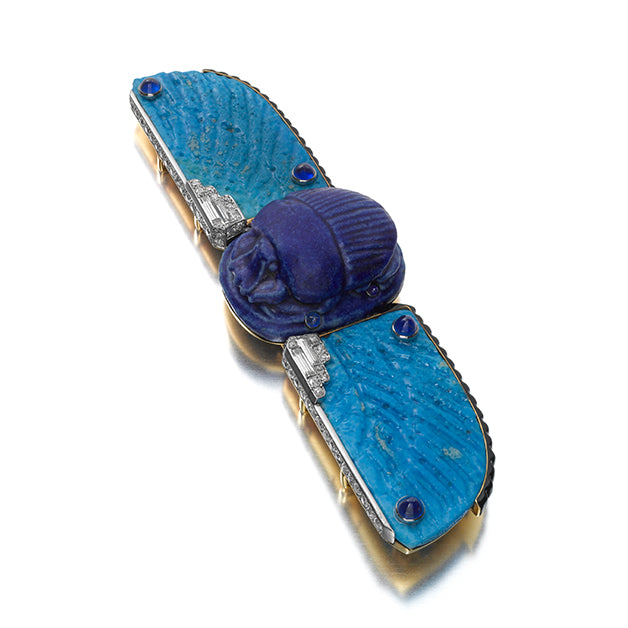
Cartier, Paris, sketch of the Scarab Belt Buckle Brooch, 1926. In his 1967 biography of Cole Porter, George Eells described a party given by Elsa Maxwell in 1928 where Linda was “. . . admired for the chic of her sapphire blue satin dress which had been designed especially to show off a Cartier ornament, a huge lapis blue scarab set with two old faience turquoise Egyptian wings, held together in a setting with long diamonds.”

Scarab Belt Buckle Brooch as seen at the Cartier in America exhibition at the Legion of Honor in San Francisco alongside two other similar cartier brooches. The exhibition ran from December of 2009 until May 2010 and saw over 175,000 visitors.

A photo from a costume ball featuring Cole Porter (left), Fuclo di Verdura (center), and Linda Lee Porter (second from right). Photo from the album of Princess Natalie Paley now at the Beinecke Rare Book and Manuscript Library, Yale University. Linda Lee Porter gifted this Cartier set to Natalie Paley.

Princess Natalie Paley photographed by Edward Steichen, circa 1935. A member of the Romanov family, Princess Paley was first cousin to Tsar Nicholas II. Expatriated to France, she became a fashion model, socialite, and actress known for her great beauty and exceptional style.

A drawing of the scarab brooch in Vogue, November 15, 1927, in an article titled “Paris Jewellery” remarking on the new jewels on the Paris scene. “Mrs. Cole Porter wears an unusual buckle made by Cartier from a scarab in deep lapis-blue with two wings in turquoise-blue. The wings are framed in sapphires and diamonds with a design of baguette diamonds.”
THE COLE PORTER SCARAB: AN ART DECO EGYPTIAN FAIENCE, BLACK ENAMEL, SAPPHIRE, AND DIAMOND BELT BUCKLE BROOCH BY CARTIER, PARIS, 1926
THE COLE PORTER SCARAB: AN ART DECO EGYPTIAN FAIENCE, BLACK ENAMEL, SAPPHIRE, AND DIAMOND BELT BUCKLE BROOCH BY CARTIER, PARIS, 1926
SOLD: Acquired by the Cartier Collection
A belt buckle of ancient Egyptian faience wings embellished with diamonds, sapphires, and black enamel, centering a large carved scarab symbolizing the god Khepera; mounted in red and yellow gold and platinum, with French assay marks
- Signed Cartier 0123 with workshop marks for Renault
- Reproduction of original drawing
- Measurements: 5 x 1 1/2 inches
Additional cataloguing
Certification
- Cartier Certificates of Authenticity GE2011-145, dated November 11, 2011, stating the brooch is “Cartier Paris, 1926.”
Provenance
- Linda Lee Porter (Mrs. Cole Porter)
- Princess Natalie Paley (Mrs. John C. Wilson)
Literature
- Busch, Jason T., and Catherine L. Futter. Inventing the Modern World: Decorative Arts at the World’s Fairs, 1851–1939. New York: Skira Rizzoli, 2012, p. 218.
- Young-Sánchez, Margaret, et. al. Cartier in the 20th Century. New York: The Vendome Press, 2014, pp. 78–79.
Exhibition
- Brilliant: Cartier in the 20th Century, Denver Art Museum, Denver, November 16, 2014–March 15, 2015.
- Inventing the Modern World: Decorative Arts at the World’s Fairs, 1851–1939,The Nelson-Atkins Museum of Art, Kansas City, MO, April 14–August 19, 2012; Carnegie Museum of Art, Pittsburgh, PA, October 13, 2012–February 24, 2013; New Orleans Museum of Art, New Orleans, LA, April 12–August 4, 2013; Mint Museum of Art, Charlotte, NC, September 22, 2013–January 19, 2014.
- Cartier and America. Legion of Honor, Fine Arts Museums of San Francisco, San Francisco, December 19, 2009–May 9, 2010.
Biography
Cartier was founded in Paris in 1847 by Louis-François Cartier. His three grandsons, Louis, Pierre, and Jacques, built the house into a famous international jewelry empire serving royalty, Hollywood stars, and socialites. Cartier has created some of the most important jewelry and objects of art of the twentieth century with many iconic designs such as mystery clocks, Tutti Frutti jewelry and the Panthère line. In 1983, The Cartier Collection was established with the objective of acquiring important pieces that trace the firm’s artistic evolution. Today, Cartier has 200 stores in 125 countries.
Significance
Egyptian culture has influenced artists and designers since Napoleon first excavated in Egypt in 1789. But the style did not come to full fruition until Howard Carter discovered King Tutankhamen’s tomb in 1922. Cartier created jewelry inspired by objects from the excavation, and sometimes, as in this belt buckle brooch, combined ancient artifacts in modern settings. This piece was formerly in the collection of Linda Lee Porter, wife of musical composer Cole Porter. She wore it to a party, given by Elsa Maxwell, on a sapphire blue dress that had been designed to show off the lapis lazuli scarab belt buckle brooch.
This belt buckle brooch epitomizes Cartier’s foray into creating jewelry that integrates ancient artifacts into a contemporary composition. The scarab and wings are formed of Egyptian faience with the deep blue wings set off by four cabochon sapphires with baguette and round diamonds that accentuate the design. Only seen when the piece is turned over, the grille work on the reverse mirrors the feathers on the front. This feature characterizes a superb jeweler who finishes the underside with the same attention to detail as the obverse.
Cartier created only a few jewels in the mid 1920s that incorporate ancient artifacts into a modern design. This belt buckle brooch, a truly striking work of art, is one of the largest known and most remarkable examples.

Cartier, Paris, sketch of the Scarab Belt Buckle Brooch, 1926. In his 1967 biography of Cole Porter, George Eells described a party given by Elsa Maxwell in 1928 where Linda was “. . . admired for the chic of her sapphire blue satin dress which had been designed especially to show off a Cartier ornament, a huge lapis blue scarab set with two old faience turquoise Egyptian wings, held together in a setting with long diamonds.”

Scarab Belt Buckle Brooch as seen at the Cartier in America exhibition at the Legion of Honor in San Francisco alongside two other similar cartier brooches. The exhibition ran from December of 2009 until May 2010 and saw over 175,000 visitors.

A photo from a costume ball featuring Cole Porter (left), Fuclo di Verdura (center), and Linda Lee Porter (second from right). Photo from the album of Princess Natalie Paley now at the Beinecke Rare Book and Manuscript Library, Yale University. Linda Lee Porter gifted this Cartier set to Natalie Paley.

Princess Natalie Paley photographed by Edward Steichen, circa 1935. A member of the Romanov family, Princess Paley was first cousin to Tsar Nicholas II. Expatriated to France, she became a fashion model, socialite, and actress known for her great beauty and exceptional style.

A drawing of the scarab brooch in Vogue, November 15, 1927, in an article titled “Paris Jewellery” remarking on the new jewels on the Paris scene. “Mrs. Cole Porter wears an unusual buckle made by Cartier from a scarab in deep lapis-blue with two wings in turquoise-blue. The wings are framed in sapphires and diamonds with a design of baguette diamonds.”





